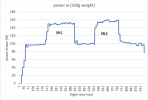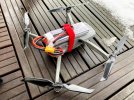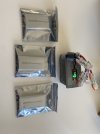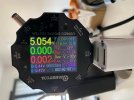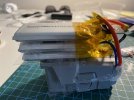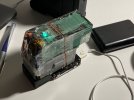I have been experimenting over a year with external batteries on my Mavic Air 2. As you all know, this is a delicate subject as extra power means extra weight, which increases power consumption and might even decrease propeller efficiency.
To do the test, I attached a bottle to my drone, and used a precision balance to measure its weight. I added 50, 100, 150... 300ml of water. The holding mechanism (originally for dropping objects) weighs an extra 80g.
Here is the setup on the ground and in the air:
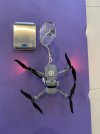

I measured the drawn power by downloading the flight log. Power = battery_voltage * drawn_current
A typical log looks like this (I lift the bottle, then put it back by lowering altitude, then lift again, and take the average consumption why lifting):
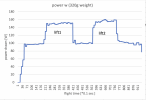
Here is the chart:
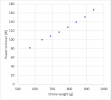

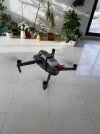
Conclusion:
You can increase flight time by external batteries, but not dramatically (max. +20%). You will compromise flight safety (unbalanced drone, cables touching propellers, etc.) and motors will be very hot. That said, I needed to try anyway, so why not post the results?
To do the test, I attached a bottle to my drone, and used a precision balance to measure its weight. I added 50, 100, 150... 300ml of water. The holding mechanism (originally for dropping objects) weighs an extra 80g.
Here is the setup on the ground and in the air:


I measured the drawn power by downloading the flight log. Power = battery_voltage * drawn_current
A typical log looks like this (I lift the bottle, then put it back by lowering altitude, then lift again, and take the average consumption why lifting):

Here is the chart:

- The stock drone is 570g, which is the first data point. Flight efficiency is the best
- At 120g weight, this data point is slightly outlier: the bottle was too light and it was wobbling in the drone's wind
- As weight is increased, power increases and also efficiency decreases: at 940g weight the drone consumes more than double as at 570g!
- Going above 800g caused the motors to be very hot (70C)


- Stock drone: 30min30s hover time (DJI claims 34 mins flight time - LOG: )
- 165g, 2600mAh LiHV: 32 min hover time (LOG: )
- 250g, 4000mAh LiHV: 36 min hover time (LOG: )
Conclusion:
You can increase flight time by external batteries, but not dramatically (max. +20%). You will compromise flight safety (unbalanced drone, cables touching propellers, etc.) and motors will be very hot. That said, I needed to try anyway, so why not post the results?




